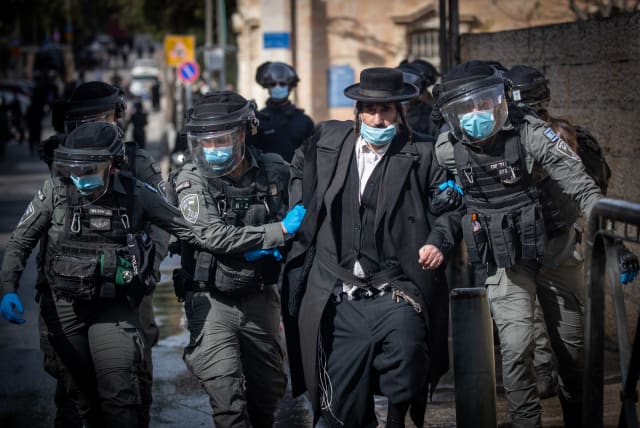Can Israel ever make peace with the haredi sector? - opinion

How might we make liberal-democratic-Zionist thought more haredi-inclusive?
Hostilities and distrust between the two sides have been building for quite a while, and COVID-19 only added to those feelings. The conflict has become so dramatic it rated a feature story in last week’s New York Times.
How can we bridge the divide?
The religious-secular divide is a significant source of conflict worldwide, but it has particular significance in Israel.
One of the predominant themes in Jewish history is that internal conflict leads to destructive, deadly consequences. The message couldn’t be more vital when we take note of the tragic flaw of internal discord that resulted in the destruction of the Second Temple and the loss of a homeland that brought about long and bitter exile.
What can each of us do to lower the temperature and move forward together?
The answer is partly structural and political, and partly systemic, and changes need to be made. But we also need profound and transformative changes initiated by the parties to the conflict themselves. Transformative changes can only take place when they are consistent with a group’s essential worldview. For change to be effective, it needs to be in the group’s language.
A brilliant effort has been proposed by Rabbi Yehoshua Pfeffer, editor-in-chief of Tzarich Iyun, a journal available in both English and Hebrew that publishes thoughtful, reflective essays of interest to haredi society.
Pfeffer believes that one way to engage the haredi community in a pro-social stance toward civil society is to renew the traditional religious value of derech eretz, the obligation to care for the community in which one lives. The sages saw the Jewish value of derech eretz as a religious obligation, a mitzvah, which was later undermined by the Jewish experience of persecution as a minority in hostile cultures. If the ultra-Orthodox were to see and teach cooperation for the greater good in that way – the authentic way – it would be understood to be a religious duty instead of a threat or compromise.
Pfeffer’s profound idea can have a powerful social impact. It is a model for the other sectors to consider when seeking to make their transformative changes. How might we make liberal-democratic-Zionist thought more haredi-inclusive?
For Israel’s Zionist majority, internal transformation is perhaps a more significant challenge than it is for haredi minorities. The Zionist majority spans a broad spectrum of values and critical dimensions, including religious, secular, liberal,and conservative. It lacks the unique cognitive, religious or cultural framework or commitment such as haredim have to follow the haredi lifestyle. Nevertheless, an inclusive, cooperative framework is possible.
Some work has been done in the United States, where the issues are, of course, different in many ways. But there are similarities between the destructive dynamics of social animosity and political polarization in America and Israel.
PROFESSOR EITAN HERSH noted that most Americans, especially those who lean Left, lack focus and cohesion compared to the passion and target-oriented approach of the Right. He coined the term “political hobbyist” to describe the way most people follow politics ineffectively. After reading about it, talking about it, pontificating about it with friends and family, they don’t actually do much. Politics is generally followed the same way people follow sports; as entertainment, and as a form of self-identity.
Hersh argues that this political involvement only serves an individual’s emotional and intellectual needs while providing an illusion of engagement. He suggests a different way to be involved in politics: by serving the community and its institutions. He recommends combining political engagement with a commitment to building a better country.
Perhaps we can build on that idea. Israel needs to enlist its best scholars and thinkers, and utilize their talents and tools to address this issue. The health of our nation and the happiness of our future depend on it. A few have already begun grappling with the issue.
In his recent book, The Wondering Jew, Micha Goodman examines Zionism’s earliest religious and secular thinkers, and he finds that they exhibited an attitude of openness to learning from others’ messages. He reminds us that over the years, Israeli surveys have found most Jews to be affirmative about Jewish belief and practice. The noisy and ugly extremes of society can be discouraging, but a good look at the big picture reveals a lot that binds us regardless of our differences.
Haredi life is characterized by separation and isolation. But are non-haredi people all that different? We all tend to live within our comfort zones, with people who share our values, lifestyle and prejudices, and who confirm our biases.
One of the authors I interviewed for my podcast is a brilliant writer, widely traveled, and open to diverse experiences and cultures. Nevertheless, she had never met or even spoken to an ultra-Orthodox Jew until a serendipitous chance encounter. Contrary to her assumptions, when she met her neighbor, she found her gracious, warm and inviting.
By showing the ordinary human lives of haredim, the TV show Shtisel has become immensely popular in Israel and beyond. It is a soap opera that works because it focuses on the families, relationships and feelings of ordinary people in a different culture. However, it is hard to empathize with those one has never met and whose way of life appears impenetrable.
We owe it to ourselves and our communities to get to know our neighbors, our brothers and sisters. It’s time to work toward peace here at home.
Renee Garfinkel, PhD is a psychologist, writer, Middle East TV commentator and host of The Van Leer Institute Series on Ideas with Renee Garfinkel.
Jerusalem Post Store
`; document.getElementById("linkPremium").innerHTML = cont; var divWithLink = document.getElementById("premium-link"); if (divWithLink !== null && divWithLink !== 'undefined') { divWithLink.style.border = "solid 1px #cb0f3e"; divWithLink.style.textAlign = "center"; divWithLink.style.marginBottom = "15px"; divWithLink.style.marginTop = "15px"; divWithLink.style.width = "100%"; divWithLink.style.backgroundColor = "#122952"; divWithLink.style.color = "#ffffff"; divWithLink.style.lineHeight = "1.5"; } } (function (v, i) { });
